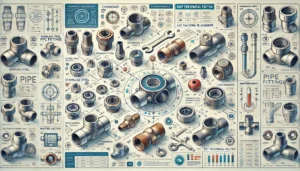The maintenance world is fast-paced, but there is one area many professionals miss which is incredibly important—advanced diagnostics. This goes beyond just fixing what is broken; it is critical to uncover the ‘why’ and ‘how’ behind the ‘what’. Advanced diagnostics is instrumental in determining the root causes of problems so that failures do not recur and the equipment does not fall short of optimal productivity and efficiency. In this article, we will thoroughly explore advanced diagnostics and all of its intricacies while explaining why it is critical in the domain of troubleshooting industrial equipment. This guide is designed for engineers of every level, ranging from the very experienced to fresh entrants. By the end of this guide, you will possess the necessary skills and knowledge to confront equipment problems head-on with the ultimate goal of reduced downtime and enhanced productivity.
2. Demystifying Advanced Diagnostics
Myth vs. Fact:
As with many other things, advanced diagnostics in an industrial environment is surrounded by myths and misconceptions. It is a common belief that advanced diagnostics is only for large scale or high tech operations but in reality, they are equally important for all businesses in order to detect and address equipment failures before they escalate. Another misconception is that these diagnostics are far too advanced and difficult to use; in reality, with the right information and equipment, maintenance crews can use such diagnostics to improve the reliability and longevity of the equipment..
Definition and Importance:
Advanced diagnostics is the use of higher level techniques and tools involving data analysis, sensor monitoring, and predictive maintenance for in-depth performance checks and issue identification on equipment beyond basic troubleshooting. Its importance stems from a more proactive approach rather than waiting for a breakdown. Advanced diagnostics enable maintenance teams to predict and schedule maintenance, reducing unplanned downtime. In today’s world, where everything needs to be efficient and productive, advanced diagnostics are non optional. It enables businesses to make sure their equipment and machinery are functional so they do not waste time and resources, always saving them in the long run.
3. The Need for Advanced Diagnostics in Various Industries
Bullet Points on Industry Applications:
- Water Treatment Plants: Diagnostics assist in watching over filters and finding anomalies within water quality control equipment.
- Petrochemical Engineering: Diagnostics are essential for the upkeep of pipelines, valves, and reactors, and minimizing the risks of leaks or failures.
- Pharmaceutical Industry: Measurement and monitoring of keeping manufacturing tools precision and clean, impacting product quality.
- Electric Power Industry: Supplies and monitors the uninterruptible power supply the transformers and generators of a system require.
- Rubber and Textile Industry: It aids in determining the optimal effectiveness of production as well as the machinery degradation.
- Oil and Gas Refineries: Determines the safety and effectiveness of operations by monitoring drilling tools and checking for any damage to pipelines.
- MEP Projects (Mechanical, Electrical, Plumbing): Important for the predictive maintenance for HVAC systems as well as the electrical works.
Case Studies or Examples:
- Hypothetical Scenario in Water Treatment: A plant suffered from frequent downtimes due to pump failures. With the use of advanced diagnostics, engineering was able to detect inconsistencies with pressure readings which led to the identification of impeller wear. This resulted in 30% downtime reduction.
- Anonymized Real-Life Example in Petrochemical Engineering: Advanced vibration analysis was one of the most effective techniques used in a large refinery for bearing failure prediction in compressors. This technique allowed planning maintenance rather than using emergency shutdowns.
4. Understanding Your Equipment: First Step in Troubleshooting
Bullet Points Key Equipment Types:
- Valves: Leakages and blockages can be diagnosed with pressure monitoring and acoustic sensors in place.
- Pipe Fittings: Alignment and corrosion can be identified through ultrasonic detection or thermal imaging.
- Pumps: Misalignment and bearing wear can be identified through vibration analysis.
- Electric Motors: Electronic signature analysis assists in identifying voltage imbalance and overheating issues.
- Conveyor Belts in Material Handling: Monitoring for uneven belt wear or tracking issues with visual checks and sensors for wear.
Initial Assessment Tips:
- Visual Inspection: Always first check if there are any other issues like a worn item, oil leakage, or fractures in the machine part.
- Operational Monitoring: Monitoring how overheated the machine parts are and whether there are increasingly strange sounds and unusual shakes.
- Review Maintenance Records: Gaining information from the equipment’s history may help figure out the enduring problems that occur in the machine, or what parts are mostly used so they require replacing.
- Understand Manufacturer’s Guidelines: Familiarize yourself with the operational norms for each equipment type as specified by the manufacturer.
5. Advanced Diagnostics Techniques and Tools
List of Techniques:
- Vibration analysis: For rotating devices such as motor and c pumps, helps in establishing fractures caused in bearings, misalignment, or imbalance.
- Thermographic Imaging: best suited for hot regions in parts of electricity and leaks in pipes.
- Ultrasonic Testing: Useful when it comes to looking for internal damage in the material such as rusting pipes and other parts markers.
- Oil Analysis: best and most effective used for a machine with lubrication systems, it helps reveal contamination, wear particles, and degradation of the oil.
- Electrical Signature Analysis(ESA): Employs motors and engines to look for lopsided electrical signals, botched insulation, or enhanced breakdown in functioning of the machine.
- Acoustic Emission Testing: Useful in locating leaks or any structural integrity problems within the pressure vessels and tanks.
Diagnostic Tools:
Portable Vibration Analyzers: Portable instruments used to check the vibration and frequency values of machinery.
Infrared Thermal Imaging Cameras: Cameras capable of thermal imaging for the purpose of locating heat anomalies.
Ultrasonic Acoustic Flaw Detectors: Devices employing ultrasonic sound waves for defect detection within a material.
Oil Sampling Kits: Kits composed of tools and equipment used for sampling and analyzing oil from machines.
Motor Circuit Diagnostic Tools: Tools used for electrical signature diagnostics of motors and generators.
Acoustic Emission Detection Equipment: Equipment developed to listen for sounds resulting from fractures and leaks of a given part.
6. Guide Auxiliary Advanced Diagnostics:
Every Step Contains Bullet Points:
Identify Symptoms: Follow the set problem by describing what is wrong or oddly functioning in the equipment.
Initial Data Collection: Perform initial data gathering, beginning with the basic checks employing handheld analyzers.
Identify Possible Causes: Work with the data that you have and formulate solutions that fit the problem.
Diagnose the Problem: Pick the advanced diagnostic technique best suited to the entire assessment of the problem.
Conduct Comprehensive Assessments: Carry out the designated diagnostic test while observing data collection.
Interpret the Results: Look through the data and attempt to find the root causes of the problem(s).
Plan the Repair or Maintenance Work Schedule: Plan the maintenance or repair schedule based on the diagnosis done.
Tips and Best Practices:
Cross-Referencing Data: Use multiple methods where possible for a more accurate diagnosis.
Regular Calibration Maintenance: Ensure regularly calabrated accurate tools are being used for testing.
Training and Expertise: Work with trained personnel or hire experts for complex diagnostics.
Document Findings: Records of all diagnosis results having actions incorporate documented results for easy reference later.
Safety First: Walk all safety protocols and standards while carrying out diagnostics and observe all guidelines and procedures.
7. Common Challenges and How to Overcome Them
Bullet Points on Challenges:
Misinterpreting Data: Using incorrect steps to read diagnostic results can lead to misinterpreted conclusions.
- Solution: Make use of multiple methods to cross-check results and provide adequate training.
Equipment Inaccessibility: Improperly placed equipment can be difficult or dangerous to operate and interact with.
- Solution: Employ the use of remote monitoring tools equipped with portable diagnostic devices.
Outdated Equipment: Older machines may be incapable of modern diagnostic methods.
- Solution: Install outdated techniques with adaptable diagnostic approaches or sensors.
Time Constraints: Some environments may be sensitive to time and extensive diagnostics may not be feasible.
- Solution: Prefer using methods that provide fast results and ensure that maintenance activities are done during the planned maintenance windows.
Expert Advice:
- Consider guidelines offered by Induskart’s experts, who may recommend applying certain condition monitoring techniques which permit continuous examination, reducing the need for conventional, manual-based, post-diagnosis troubleshooting exercises.
8. Conclusion
The use of advanced diagnostics and their applications in the routine maintenance of industrial equipment is something that should be regarded with serious attention. These procedures and devices help in explaining, and not restricting to, assessing equipment failures, administering efficient maintenance, and ensuring equipment is functioning optimally. The accuracy of diagnosis is always a concern, but with proper skillful hands, equipped with the right tools, and sound guidance, it can be resolved effectively. One of the challenges that one has to face in these issues is dynamic changes, and maintaining agility is of essence.










